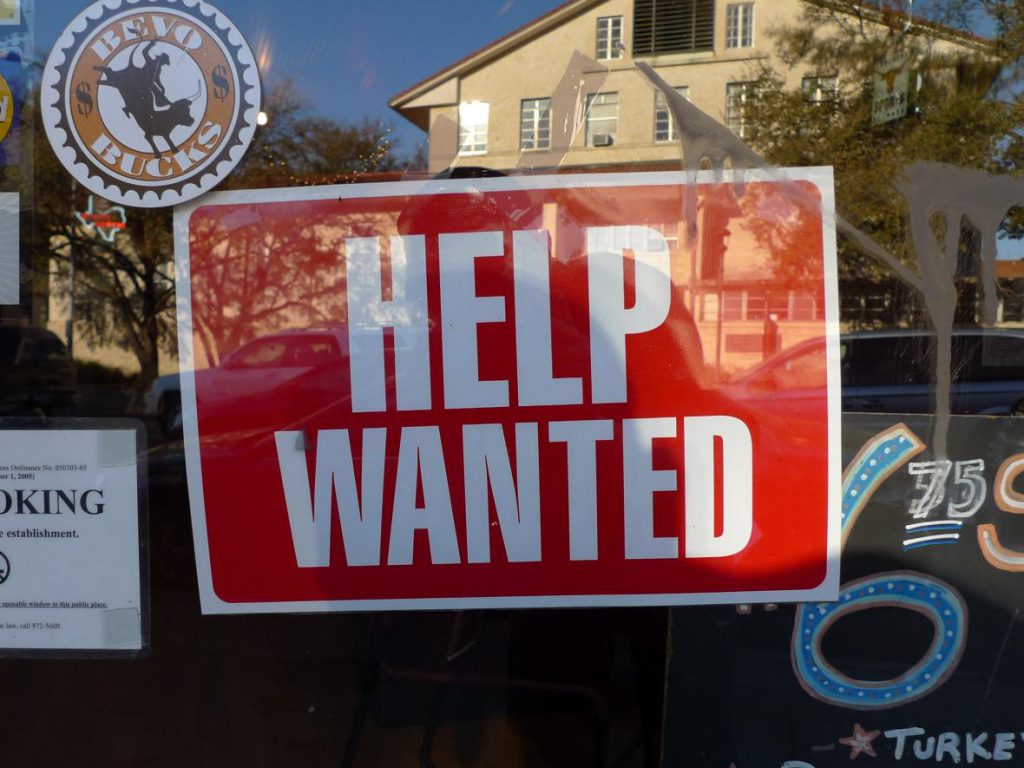Even Higher Wages Won’t Fill Open Jobs
Increase legal immigration as the reliable workforce dwindles.

Help Wanted. Photo by Andreas Klinke Johannsen (CC BY-SA 2.0)
When you talk to business people here in the Heartland, there is a constant refrain: “We can’t find employees, and it’s hurting our business.”
My wife and I were at one of our favorite local restaurants in West Bend last week, and the head waitress had to apologize for not being able to get to our table. “We hire a new person and then less than a week later, she simply doesn’t show up. They just leave with no notice.”
To take some pressure off her and the other harried waitress, we offered to move a less busy place just down the street. She understood and didn’t object. She offered to not charge for our glass of wine. It’s a great place for steaks, so we’ll be back, but it was a loss of revenue for the owners, who are friends. They are not alone.
It’s the most severe labor scarcity I’ve seen in more than 50 years of management, a very far cry from the double-digit jobless percentages a decade ago. And don’t tell me that the labor scarcity isn’t having a beneficial upward movement in wages.
To attract workers, a local nursing home is now paying $19 per hour for unskilled people. That’s up $5 over the last decade. Though rewarding in some ways, it’s tough work, so maybe that is a fair wage.
Baby-sitters are making as much as $15 per hour.
“We’re hiring” signs are hanging outside almost every establishment in Wisconsin, where the unemployment rate is below 3%. That means there are lots of options for workers, especially inexperienced workers. New employees sign on, but keep looking for a better deal down the street.
That has several major consequences for the economy beyond the upward pressure on wages.
Candidates don’t look so much at benefits today, because there is a growing parity on benefit packages. To hire, companies have had to improve their benefits to be up to par. Candidates at medium-size and large companies used to look especially for a rich health care plan. Now that’s a given at all but small companies. That’s a rising boat for many people, especially when health care costs are still rising way too fast.
When benefit packages are a wash, the focus is on base wages. “It’s a war of wages,” said one human resources manager.
U.S. wages in general grew 3.4% in 2018, well above the inflation rate of around 2% or less. Younger workers, even those without degrees, are seeing sharp increases, even if they have to move to win them. Older works are not doing as well, with wages just keeping up with inflation.
So, what’s an employer in the Heartland to do beyond raising wages?
The first line of defense is to fully engage people in their enterprise. That’s especially true in the first year when the churn can be more than 40%. In manufacturing companies, the turnover can run as high as two-thirds in the first year. Make new hires feel part of the company. Wages aren’t everything.
The off-shifts are the hardest to fill, so employers are looking for ways to put more work on the first shift. That can mean adding machines for first shift workers to operate.
Automation is a compelling answer. Most employees understand and welcome those advancements. Who wants to do highly repetitive work? People want to use their brains at work.
Employers are offering more training and career advancement plans. Employees will stay longer when a company invests in their talents.
What can the government do? That’s a tough one in a state like Wisconsin where the population is not growing and baby boomers are retiring in big numbers, thanks in part to well-managed retirement 401K plans and a decade of rising stock markets.
Most states are trying to ramp up hard and soft skill training for people previously considered unemployable. The bottom-line truth, though, is that employers will work with almost anyone, including ex-convicts, if they just show up for work on a reliable basis and show a reasonable level of willingness and responsibility.
In short, employers are getting really creative to fill openings. But that’s not enough if there simply aren’t enough people out there.
Here’s a radical idea that most CEOs would support. This country has been built on the hard work and new energy of immigrants. Let’s to go back to one million legal immigrants per year, like it was before President Trump cut the number in half.
John Torinus is the chairman of Serigraph Inc. and a former Milwaukee Sentinel business editor who blogs regularly at johntorinus.com.
Op-Ed
-
Unlocking Milwaukee’s Potential Through Smart Zoning Reform
 Jul 5th, 2024 by Ariam Kesete
Jul 5th, 2024 by Ariam Kesete
-
We Energies’ Natural Gas Plans Are A Mistake
 Jun 28th, 2024 by John Imes
Jun 28th, 2024 by John Imes
-
Milwaukee Needs New Kind of School Board
 Jun 26th, 2024 by Jordan Morales
Jun 26th, 2024 by Jordan Morales





















If employers are willing to give people returning from prison and minorities a job, they will find some willing and hard-working employees. Immigrants need a path to citizenship, not a quota on how many can come.